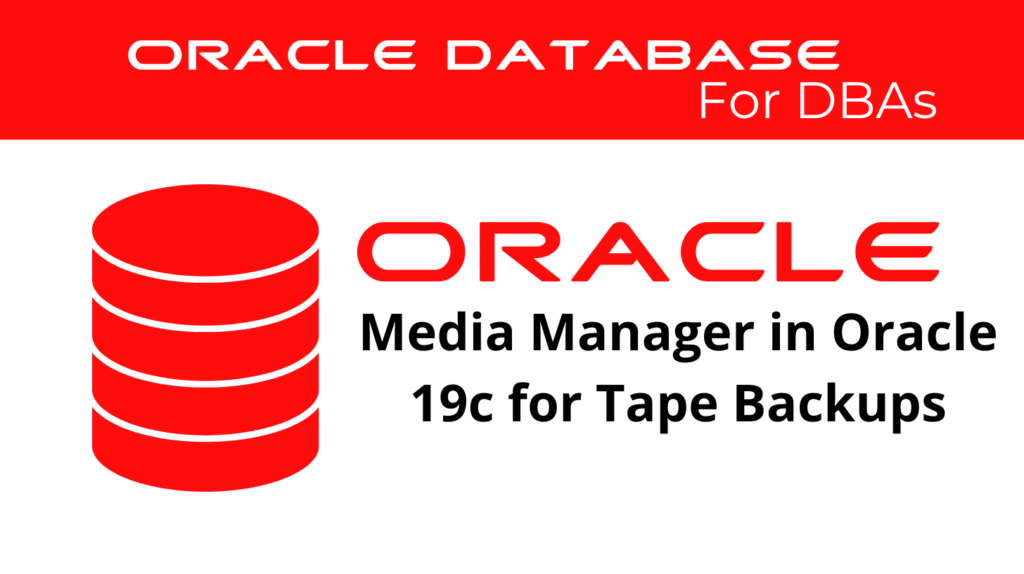
In the modern database environment, protecting data through effective backup and recovery processes is crucial. Organizations that utilize tape as a backup medium benefit from Oracle 19c’s robust support for media managers. These tools handle the communication between Oracle’s Recovery Manager (RMAN) and tape storage devices. By integrating a media manager, you can ensure that backups are efficiently managed and securely stored on tape.
Introduction to Media Management in Oracle
Tape backups have been a fundamental part of data protection strategies, especially for long-term storage and disaster recovery. Oracle 19c makes this process seamless by integrating media managers that handle the communication between RMAN and tape storage devices. With a media manager, your organization can ensure backups adhere to best practices and are stored securely offsite or in a dedicated storage system.
Configuring Oracle 19c for Tape Backups with a Media Manager
Before using RMAN with a media manager, you need to complete specific configurations. These steps include setting up the media management library, configuring channels for tape backups, and ensuring RMAN communicates effectively with the media manager.
📢 You might also like: Oracle 19c Multi-section Backup for Large Files (Category: Oracle Database Admin)
Installing and Configuring the Media Manager
To use a media manager with Oracle 19c, begin by installing the necessary media management software on the database host. This software acts as the interface between Oracle RMAN and the tape storage system. Follow the vendor’s documentation to ensure proper installation and configuration. Once set up, validate the integration to ensure seamless communication between RMAN and the media manager.
Configuring the Media Management Library Location
Determining the correct location of the media management library is essential for RMAN to communicate with tape devices. On Linux and UNIX systems, the SBT library, vital for tape backups, typically resides in a specific directory. The path might look something like:
/opt/oracle/extapi/64/SBT/VENDOR/VERSION/libobk.so
On Windows systems, the SBT library is usually located at:
%SYSTEM_DRIVE%\oracle\extapi\64\SBT\VENDOR\VERSION\orasbt.dll
Configure RMAN to use this library with the following command:
CONFIGURE CHANNEL DEVICE TYPE sbt PARMS 'SBT_LIBRARY=pathname';
By configuring this parameter, RMAN gains the ability to load the media management library and initiate communication with tape devices through the media manager.
Configuring SBT Channels for Tape Backups
After locating the library, set up the channels that RMAN will use to perform tape backups. These channels facilitate communication between RMAN and the media manager.
To configure an SBT channel, use this command:
CONFIGURE CHANNEL DEVICE TYPE sbt PARMS 'ENV=(OB_DEVICE=tape1)';
This command sets the necessary environment settings for the media manager. For environments with multiple tape drives, consider configuring parallelism to enable RMAN to write backups to multiple tapes simultaneously:
CONFIGURE DEVICE TYPE sbt PARALLELISM 2;
This setup optimizes tape backup operations by distributing the workload across multiple tape drives.
Testing RMAN Tape Backup Integration
Before conducting full-scale backups, test the integration between RMAN and the media manager. Start by allocating an SBT channel and attempting a basic backup, such as the server parameter file (SPFILE):
RUN
{
ALLOCATE CHANNEL c1 DEVICE TYPE sbt
PARMS 'SBT_LIBRARY=/mydir/lib/libobk.so, ENV=(OB_DEVICE=tape1)';
BACKUP SPFILE;
}
Successful completion of this operation confirms that RMAN is correctly integrated with the media manager, allowing you to proceed with regular backups.
Advanced Media Manager Configuration Options
Further configuration may be required to optimize tape backups for specific environments. These configurations include setting backup piece names, managing backup piece sizes, and establishing tape retention policies.
Setting Backup Piece Names
The media manager treats backup piece names as file names, necessitating that every backup piece has a unique name in the media management catalog. Oracle provides several substitution variables, such as %d for the database name and %t for the timestamp, which can generate unique names. The following configuration ensures that RMAN creates unique names for each backup piece:
CONFIGURE CHANNEL DEVICE TYPE sbt FORMAT '%U';
This setup is crucial for environments where tape management systems require specific naming conventions.
Managing Tape Backup Piece Sizes
Certain media managers impose limits on the maximum size of files they can manage. If your environment has such restrictions, utilize the MAXPIECESIZE parameter in RMAN to ensure that backup sets do not exceed these limits:
CONFIGURE CHANNEL DEVICE TYPE sbt MAXPIECESIZE 2G;
This configuration ensures that no single backup piece exceeds 2GB, which might be necessary for older tape systems or specific regulatory compliance requirements.
Best Practices for Tape Backups with RMAN
To ensure reliable and efficient tape backups with RMAN, follow these best practices:
- Regular Testing: Periodically test your backup and restore processes to confirm that tapes and the media manager function correctly. This includes performing regular restore tests to verify the integrity of your backups.
- Documentation: Maintain detailed documentation of your media manager configuration, including library locations, channel configurations, and any custom settings. Documentation is essential for troubleshooting and maintaining compliance with organizational policies.
- Monitoring: Use Oracle’s built-in monitoring tools to track backup performance and media manager operations. Monitoring helps identify potential issues early and ensures that your backup windows are consistently met.
Conclusion
Integrating a media manager with Oracle 19c for tape backups is a powerful way to enhance your data protection strategy. By configuring the media management library, setting up RMAN channels, and adhering to best practices, you can ensure that backups are securely stored on tape and readily available for recovery. Testing your configurations thoroughly and documenting your setup will maintain a robust and reliable backup environment.
See more on Oracle’s website!
Be Oracle Database Certified Professional, this world is full of opportunities for qualified DBAs!





